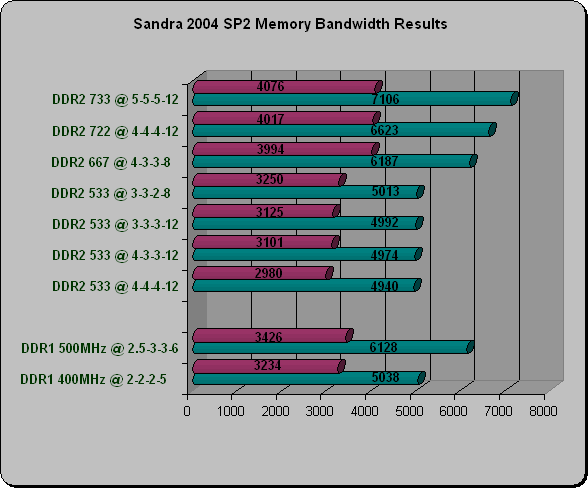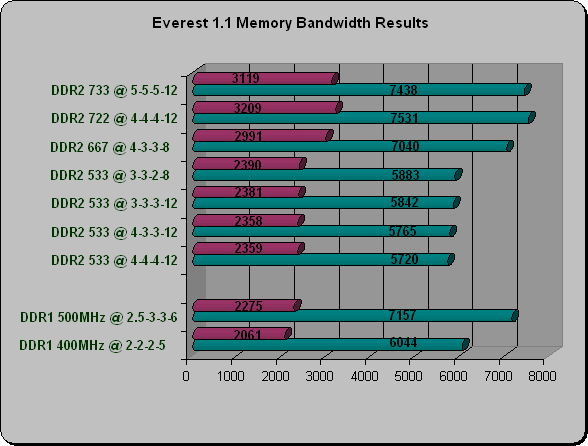Is DDR2 Ready To Replace DDR1???
Memory Bandwidth Testing:
Sisoft; Sandra 2004 SP2:
Sisoft Sandra 2004 is designed to test the theoretical power of a complete system and individual components. The numbers taken though are, again, purely theoretical and may not represent real world performance. Higher numbers represent better performance in memory bandwidth.

Results:
Since most people are picking up DDR2 PC-4200 memory we showed DDR2 at four different memory timings to see if tight timings help performance. Even after running our DDR2 533MHz memory at super tight timings of 3-3-2 (3-2-2 is the tightest possible) we found that it was in a dead tie with DDR1 400 at timings of 2-2-2. It was only when we overclocked our DDR2 memory beyond 667MHz that we started to see the area that DDR2 really shines and that is unbuffered bandwidth. We can take a close look at DDR1 500 and DDR2 667 (because both CPU’s are set the same: 250FSB x 15), here we can note almost 600MB/Sec more memory bandwidth for DDR2 over DDR1. From DDR667 and above DDR2 looks really good in terms of memory bandwidth especially in unbuffered performance.
Everest Version 1.1:
Everst 1.1 is a professional system information, diagnostics and benchmarking program for Win32 platforms. It extracts details of all components of the PC. It also tests the actual read and write speeds of your memory giving a fairly accurate look of true memory performance.

Results: It’s fairly obvious that the 533MHz DDR2 memory found on our Intel 560 test system performed on par with 400MHz DDR1 memory. Yes, in some areas such as Everest READ testing DDR2 pulled ahead, but not enough to make us jump up and down. One of the reasons that improvements to the memory bus seem lackluster to us is because recent Intel and AMD processors have not been “starved” when it comes to memory bandwidth. Meaning improvements found here more than likely wont translate to real world performance gains, but more bandwidth can’t technically hurt your system!
ScienceMark 2.0 Beta:
ScienceMark 2.0 is different from other benchmarks, in a sense the benchmark tests a series of different memory bandwidth algorithms. To top it all off the assembly source for these copy routines is available online to help assure the benchmark is not biased towards any one platform in particular.

Results: ScienceMark again confirms what we have been seeing on Sandra and Everest!

Comments are closed.